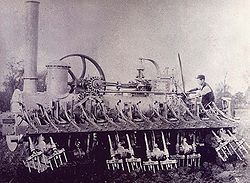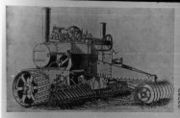
Darby Steam-Digger
Encyclopedia

Traction engine
A traction engine is a self-propelled steam engine used to move heavy loads on roads, plough ground or to provide power at a chosen location. The name derives from the Latin tractus, meaning 'drawn', since the prime function of any traction engine is to draw a load behind it...
, was invented circa 1879 by farmer Thomas Darby and built at Lodge Farm Pleshey
Pleshey
The village of Pleshey lies in Essex, England, just to the northwest of Chelmsford.William the Conqueror gave Pleshey, in the parish of High Easter to Geoffrey de Mandeville in appreciation of his services; Mandeville was one of William's battle commanders at the Battle of Hastings in 1066...
, near Chelmsford
Chelmsford
Chelmsford is the county town of Essex, England and the principal settlement of the borough of Chelmsford. It is located in the London commuter belt, approximately northeast of Charing Cross, London, and approximately the same distance from the once provincial Roman capital at Colchester...
in Essex
Essex
Essex is a ceremonial and non-metropolitan county in the East region of England, and one of the home counties. It is located to the northeast of Greater London. It borders with Cambridgeshire and Suffolk to the north, Hertfordshire to the west, Kent to the South and London to the south west...
, England
England
England is a country that is part of the United Kingdom. It shares land borders with Scotland to the north and Wales to the west; the Irish Sea is to the north west, the Celtic Sea to the south west, with the North Sea to the east and the English Channel to the south separating it from continental...
. Robert Hasler, seen driving the Digger, helped to build this first prototype.
In effect the machine was an early tractor
Tractor
A tractor is a vehicle specifically designed to deliver a high tractive effort at slow speeds, for the purposes of hauling a trailer or machinery used in agriculture or construction...
designed mainly for ploughing, and could accomplish 1 acres (4,046.9 m²) an hour (1 m²/s) to a maximum depth of 14 inches (360 mm). This first digger was constructed on pedestrian principles and had six "feet" and really did walk over the fields. Unfortunately it jumped too much to be really successful. The digger was later modified to have wheels in place of the legs. This machine pre-dated the Ivel tractor built by Dan Albone of Biggleswade in 1902 which he started designing in 1896.Classic Farm Tractors, by Micheal Williams, ISBN 978-0-7537-1446-1 The Ivel tractor is generally considered to be the first British tractor with an internal combustion engine
Internal combustion engine
The internal combustion engine is an engine in which the combustion of a fuel occurs with an oxidizer in a combustion chamber. In an internal combustion engine, the expansion of the high-temperature and high -pressure gases produced by combustion apply direct force to some component of the engine...
.
Robert Hasler was born in Pleshey in 1856; he worked as an engineer for Thomas Darby for 26 years, then became the village blacksmith
Blacksmith
A blacksmith is a person who creates objects from wrought iron or steel by forging the metal; that is, by using tools to hammer, bend, and cut...
(following his father) until he retired in 1925. At the age of 19 he was badly kicked by a horse, and this necessitated one of his legs being amputated.
Second version

Third version
The third version was more like a conventional traction engine with the Digger attached behind - it had spades that actually dug into the ground and turned the soil over.External links
- Reading University MERL project Photo in the MERL Library data base

